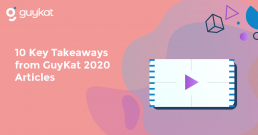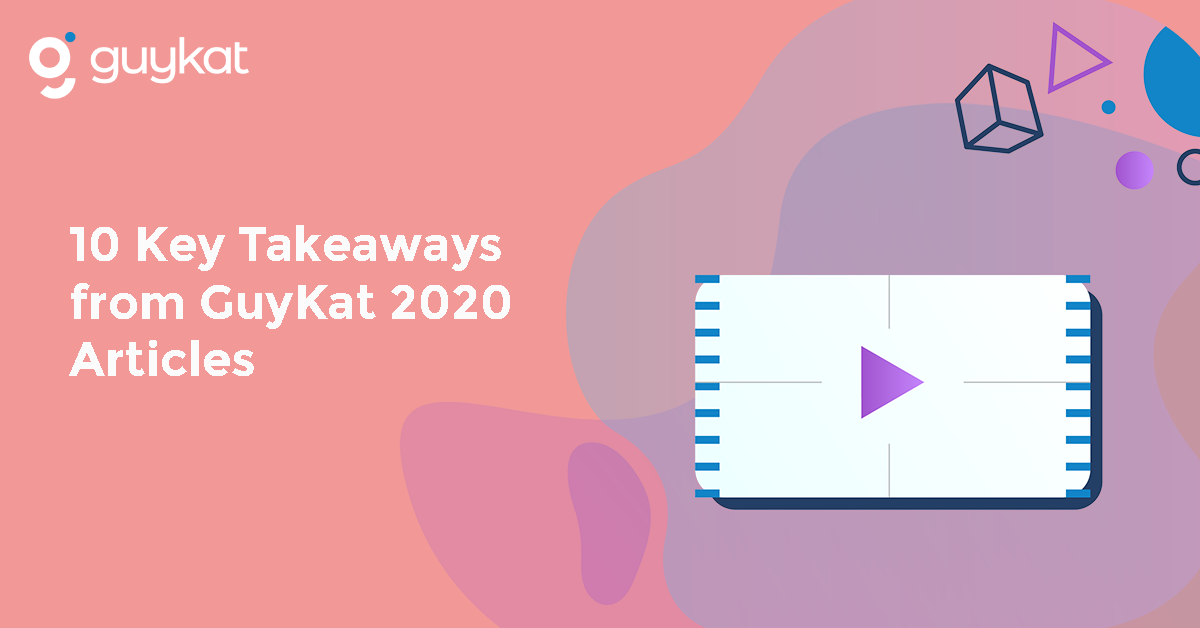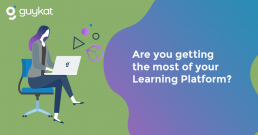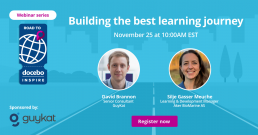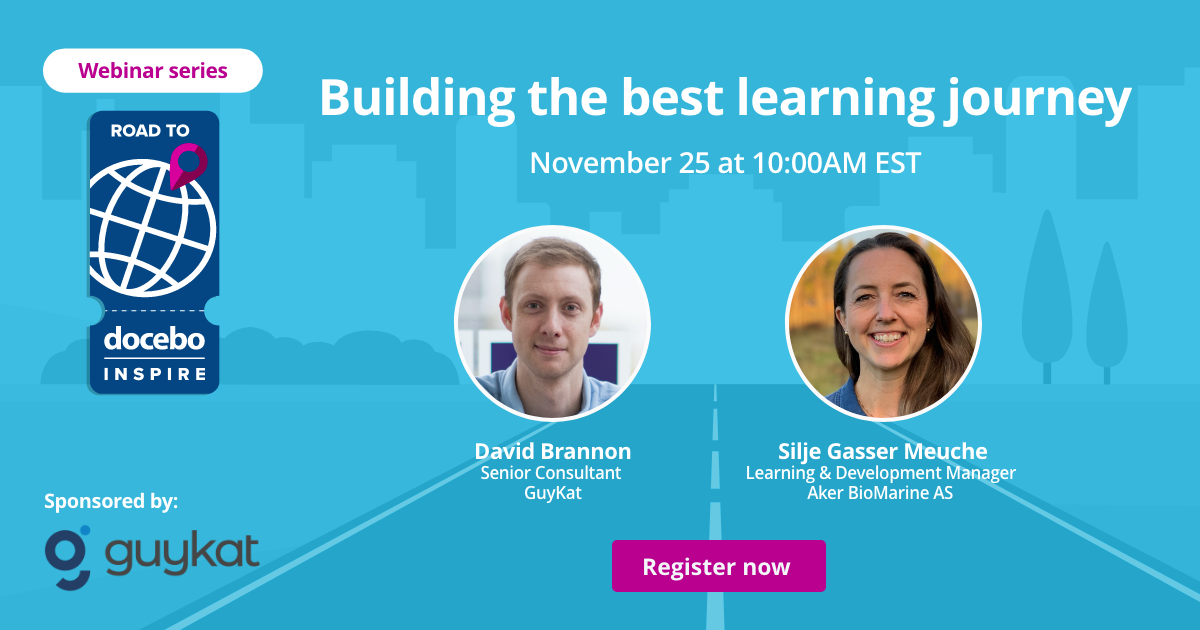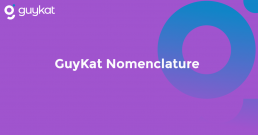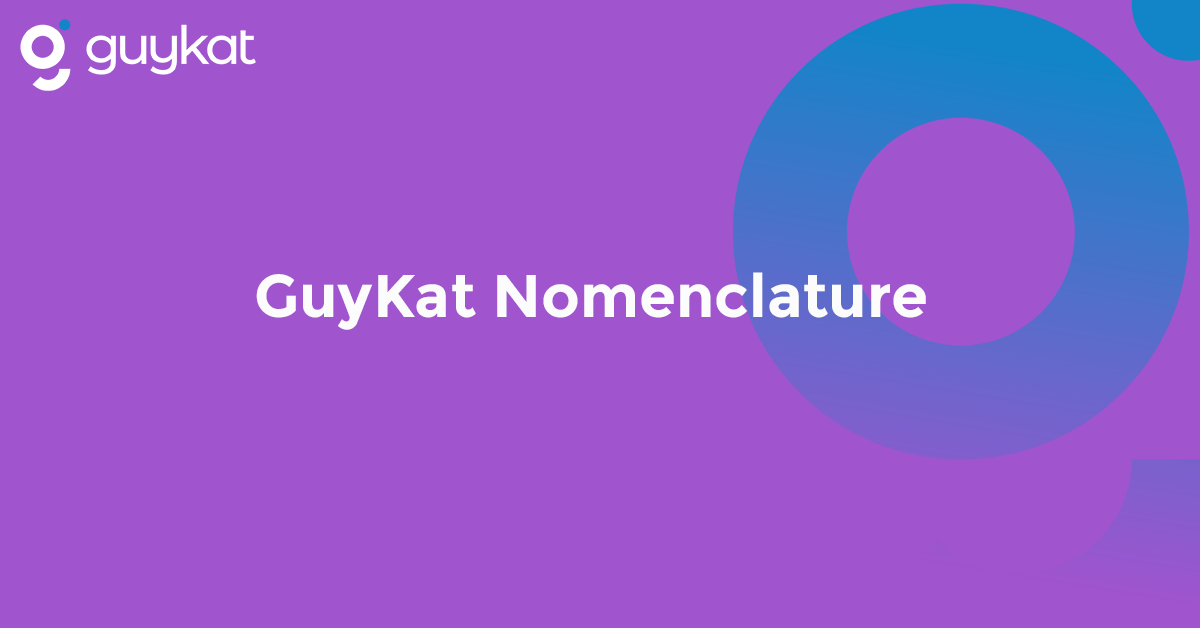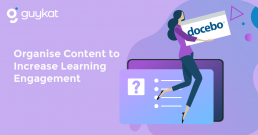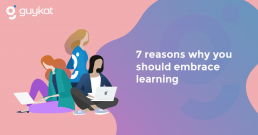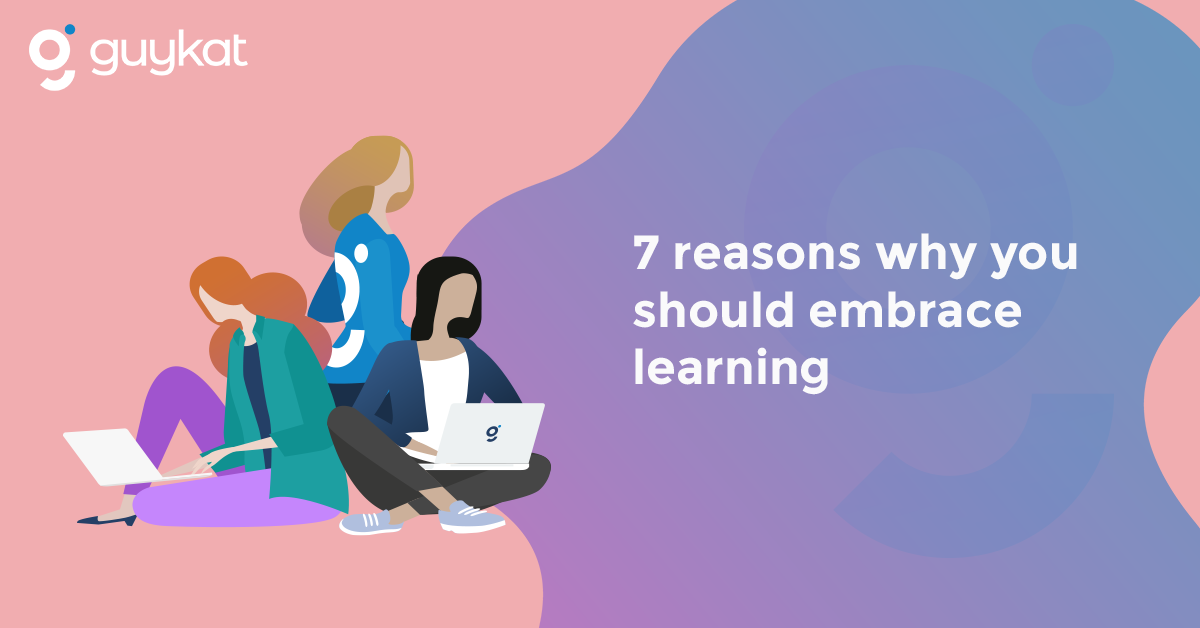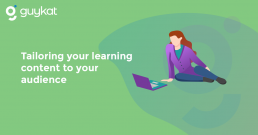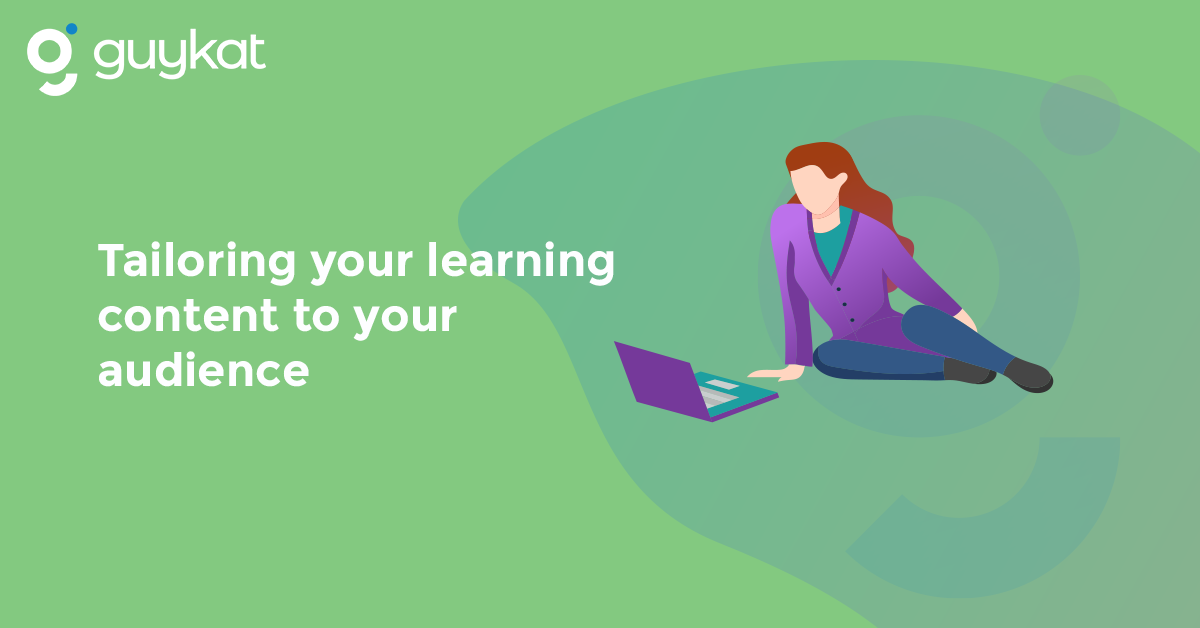10 key takeaways from GuyKat 2020 articles
We’ve shared a ton of content via articles in 2020. We thought it would make a nice end to the year to summarise 10 Key takeaways from the thousands of words written!
Content is as important as the platform
Unfortunately, many professionals place a higher priority on their learning plan compared to content. It’s indisputable that the look and feel, flow and execution of the platform is key for the success of Learning and Development - however, this should not be the sole focus of your effort. eLearning content plays a vital role in your learning strategy. Even if your platform is the best on the market - if you're using it to present poor eLearning content to your learners it's unlikely to achieve the desired effect and have a positive learning impact. Both parts, content and platform, are important and you can’t do one successfully without the other.
Related content: How to motivate a sceptical learner
Pilot projects spare pain
Test the water of new features, functions and systems with a small pilot project first. This is a low-risk way to get feedback and refine ahead of any larger rollouts. Also, a strong proven approach (or 'template') will help establish a clear process for future projects.
Related content: The ultimate checklist for a successful multi-country rollout
Documentation matters
Keep an offline document of the configuration and decisions made during the original project for easy reference. Additionally, set-up a monthly or quarterly forum to gather feedback from your learners and identify if there are patterns in requests e.g perhaps there’s a desire to expand the social area of your platform, or rollout Gamification.
Related content: Are you getting the most of your Learning Platform?
Be mindful of your learning objectives
One key thing we tell our clients is to always include learning objectives. Sometimes learning objectives are explicitly referenced in the content e.g. you may have a screen that tells the learner “By the end of the module you will be able to explain the procurement process”. Sometimes, you may not want to be so explicit to the learner. Either way, you need to make sure that every part of the storyboard is supporting the delivery of a learning objective. Make the goals of the training clear upfront and ensure they are achieved by the end of the training. You could implement a function that allows the user to tick off objectives as they are completed to help them feel a sense of progress.
Related content: 5 steps to a successful eLearning project
Adapt your approach to your audience
Different audiences require different approaches. Just as TV shows and movies are made to target certain demographics, we need to do the same with our eLearning to ensure the information is transferred to the user in the most effective way. One of the most important questions we ask our clients before we begin development is ‘Who is this training for?’. We need to know who we are aiming the content at; the age range of the learners, their pre-existing knowledge of the topic in question, if they have taken a course like this before and so on. Knowing this information can drastically change how we design and develop our content and affects everything from the look and feel of the course to how long it takes to complete.
Related content: Tailoring your learning content to your audience
Use branding that’s authentic
Authentic look and feel encourage learners to interact with training materials, as it provides them with a sense of professionalism and motivation. You never get a second chance to make a first impression. The first experience a user has of your platform is the landing page. Putting effort into making the landing page clear and intuitive will change how users ‘feel’ about logging on to the platform. A mistake we often see is overwhelming the user with too many options, content and information. Keep it simple, clean and sign-post what to do next.
Related content: 5 easy ways to improve your Learning Platform's UX
Related content: How building a custom landing page enhances your UX
Content that’s organised in Netflix Style is the way to go
The initial one catalogue concept used to be the norm, where you show categories to the end-user and let them filter their catalogue based on those categories. However, this is not something being heavily used nowadays. We’ve seen the shift to have more, and smaller catalogues. This represents the style of modern websites such as Netflix and Youtube on the catalogue page that seems to be working well. Instead of having one massive catalogue that people have to struggle to find things, bite-size catalogues, that are auto-filtered to the end-user seems to work effectively. User-experience at it’s finest – it’s like you’re browsing your favourite Netflix genres.
Related content: Organise Content to Increase Learning Engagement
Analyse your learner’s behaviour (eLearning modules)
Keep track of user results and metrics, such as how long they spent taking the course, if they paused it and at what point if a particular question received a low average score and so on. This could clarify issues with the training and help you pinpoint where users may have lost interest or struggled.
Related content: Tailoring your learning content to your audience
Have a clear strategy if adopting user-generated content
Require expert review before content can be published. Having this setting enabled means that you can allow learners the option to contribute content, however, Admins will need to review it and consciously make a decision to approve or reject it.
Related content: User-generated content: Why is it important and how to use it effectively
Lead by example to motivate your learners
If you are the Head of Learning or Account Executive with a passion for learning – communicate that with others. Nothing compares to human communication. Be vocal about how much you love learning, why you think it’s important for you and the company and others will follow. Become an ambassador for those who need a little bit of a push and you’ll see how quickly the motivation grows.
Related content: How to motivate a sceptical learner
User Levels: How to Leverage Superadmins and Power Users on Your Learning Platform
 Implementing a successful Learning Platform is no easy feat - it takes a team! When implementing your platform, it’s essential to establish user responsibilities. You need to understand the different admin levels available since these can significantly impact user experience.
Implementing a successful Learning Platform is no easy feat - it takes a team! When implementing your platform, it’s essential to establish user responsibilities. You need to understand the different admin levels available since these can significantly impact user experience.
Often, clients’ frustration with their Learning System stems from either:
- Their system being too restricted – leading to issues such as course authors being unable to update courses or team leads being unable to run reports. This creates surplus work for the system Admin.
- Their system being too open – meaning learners can accidentally interfere with, or even damage, the intended system set-up.
These issues can be avoided by understanding the permissions associated with user levels and assigning them strategically. The steps in this article are specific to Docebo but the principals undoubtedly apply to all Learning Platforms.
Docebo employs a user hierarchy, made up of different user levels categorised by their platform permissions. You can leverage these to avoid overloading your Admin with the responsibility of all platform activities (especially when this involves extra features).
Your users can work together to spread the load when you utilise the user levels:
- Users
- Power Users
- Superadmins
Let’s dive into each level!
Users
The majority of people using your platform are likely to be basic Users. Their experience will be determined by their access to the platform’s functions, set up by a Power User or Superadmin. Your Users will have basic authorised permissions, such as attending courses or learning plans and accessing training material. They will not be able to access the Admin Menu or manage any platform features, apps, or settings.
Put simply, your Users are here to learn.
Power Users
Power Users are a level up from your basic Users. Leveraging Power Users can be a great strategy if you want to offer autonomy for managing certain groups of users, branches, or courses. Power Users will have a specific subset of permissions, determined by a Superadmin. They will be able to access the Admin Menu but their visibility will be limited to their allowed permissions.
GuyKat Tip: You can set up your ideal Power User profile and assign it to as many Power Users as you need. You can also assign multiple profiles to a single Power User, giving them all of the permissions outlined in these profiles.
Superadmins
Superadmin Users are the highest functioning users in your platform and have the greatest amount of access. They are the people who lead and maintain your platform throughout its journey. Superadmins will be able to access and configure all platform settings, features, applications, and integrations - including the platform’s look and feel. They can access all areas of the platform through the Admin Menu and there is no way of limiting their permissions.
GuyKat Tip: Superadmins have the greatest responsibility, so choose wisely! We recommend that you select 1-3 individuals to ensure the cohesive management of your platform.
So, why should you be leveraging these user levels?
If you want your users to have the right amount of influence over your Learning Platform, it’s vital to assign user levels strategically. This can elevate your system by providing you with more integrated management.
Leveraging Power Users and Superadmins can help with scaling your platform - you can more easily delegate tasks and establish accountability. Power Users have customisable permissions that can relieve your Superadmin of time-consuming activities. sharing the responsibility of maintaining and improving your Learning Platform.
Are you getting the most out of your Learning Platform?
The original version of the article written by GuyKat’s Joanne Payne can be found on LinkedIn here.
I’ve helped many clients set-up and launch their learning platforms. Careful thought is put into understanding the key audiences (internal learners, customers, instructors, managers, education team), what their needs are and what their user journey should look like. This then informs configuration/design choices we make to ensure that from the point of launch - we’re set up for success.
Fast forward 6 months down the line - the LMS is hopefully embedded to some extent within your organisation and you’re moving to a business-as-usual setting. Ask yourself these questions:
- Are you getting the level of engagement and interaction you hoped for?
- What comes next?
- Are you getting the most out of your Learning platform?
Reporting
To judge success you need a fact base and hard data. To get data you need to be confident your system reporting is properly configured. It’s important to understand:
- How many active users do you have?
- Time spent on course content.
- Courses completed vs those not started/in progress. Is there a pattern? Can you identify from this which content your users are interacting with?
- Learner satisfaction/site feedback.
Reporting, however, is only useful if it’s used to help inform future choices. E.g If your learners are interacting and regularly completing eLearning modules, but are leaving your PPT materials untouched - it may signal a need to shift how your content is created. If you’re consistently receiving feedback that learners are getting frustrated trying to find that mandatory course they’re supposed to complete - maybe take a look at your site navigation to make it more intuitive.
Related content: Organising Content to Increase Learning Engagement.
Remember that “nice-to-have” feature you got excited about during implementation (but wasn’t a priority for your pilot launch)? It’s time to revisit it!
It’s a common approach to launch your learning platform with a prioritisation on the core functionality to achieve a minimum viable product... It’s easy to forget all of the bells and whistles your learning platform has that you’ve yet to take advantage of. These functions can often be the ones that incentivise your learners to keep coming back - e.g Gamification & Rewards, Social Learning, the Branded Mobile App. Stay up-to-speed on new features being released onto your learning platform. Don’t be afraid to continue to iterate and innovate it to help keep you ahead of the curve.
If you have the option, trial setting up new features on a sandbox environment first so you can feel fully confident with then promoting it to production.
Encourage social learning/user-generated content
If you have the option within your Learning Platform to let your learners ask questions, comment/rate content or even contribute their own content - take advantage of it! This can help shift a learner’s mentality from thinking it’s “just another LMS” to feeling like it’s a community that they want to continue to come back to and feel a part of.
Devise a long term communication plan
Regularly and proactively reach out to your learners from your learning platform to let them know what’s new! Have you released a new piece of content? Have you rolled out a new feature that your users can benefit from? Let them know! Drip-feed new/exciting content on a regular basis.
So in short, if you want to get the most out of your Learning platform - don’t be complacent! Listen to the feedback you’re getting from your learners, know what features you have available (and that are upcoming) for your Learning platform and ensure continuous improvement is a part of your learning and development strategy.
Building the Best Learning Journey - Road to Docebo Inspire webinar series
At GuyKat, we believe that the best learning journeys are created in a learning platform if you focus on three different things; people, the process and the technology. All too often we see clients making the mistake of thinking about only the technology. The people and process bits matter just as much.
All three aspects need to work in tandem in order for your journey to be successful. Whatever you wish to achieve with your platform, whether it’s partner training, internal L&D or external learning you need to be mindful of all three steps.
Wednesday, 25th November, at 10 AM EST, (3 PM GMT), at the Road to Docebo Inspire webinar, our Senior Consultant David Brannon discussed what it takes to create the best learning journey for your learners.
David was joined by Silje Gasser Meuche, Learning and Development Manager at AkerBio Marine, who also shared their company’s experience in building the best learning journey for the AkerBio Marine’s use case.
Check out the webinar here:
https://www.youtube.com/watch?v=r_FNW73o5SE&feature=emb_title
GuyKat Nomenclature Video
For this year’s #DictionaryDay, GuyKat's word of the day was Nomenclature!
Nomenclature is the system of names used in a particular specialist field.
We asked the staff to define words from eLearning nomenclature. One take. No ‘camera shyness’. Be yourself.
https://www.youtube.com/watch?v=skBtlAuXPrQ
Organise Content to Increase Learning Engagement
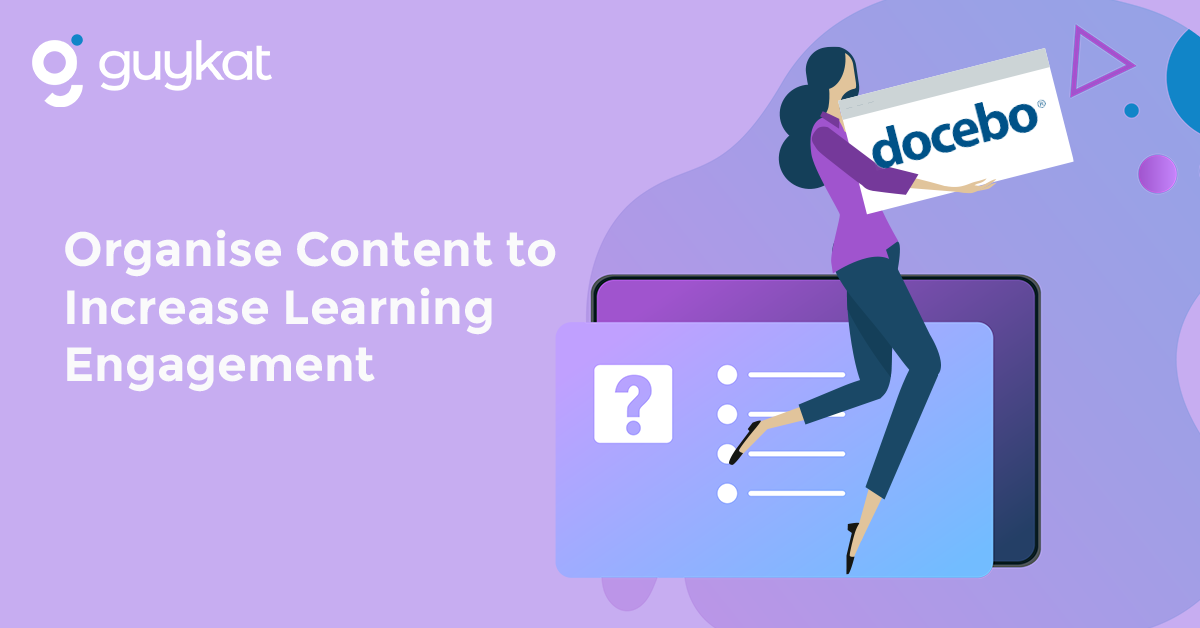 Our clients often ask “How do I make my learners want to come back to our platform?”. They can ‘force’ the learners to logon for compliance training, but ideally, they’d like learners to ‘want’ to go to the learning platform of their own accord. In our experience, there are various factors that increase employee engagement. Organised content is one of them.
Our clients often ask “How do I make my learners want to come back to our platform?”. They can ‘force’ the learners to logon for compliance training, but ideally, they’d like learners to ‘want’ to go to the learning platform of their own accord. In our experience, there are various factors that increase employee engagement. Organised content is one of them.
The best method for organising content depends on your approach to giving access to your material:
Self-enrollment
Self-enrollment is the method whereby users can choose to enrol themselves into a course and/or learning plan.
Auto-assignment
Auto-assignment is the method whereby users get assigned a course and/or learning plan based on predefined criteria, such as their role or geographic location.
In Docebo, there are three ways to organise content:
- Channels
- Catalogues
- Categories
Let’s cover each of them in more depth:
Channels
Generally, channels are aligned more to the social side of the platform, referred to as Discover, Coach & Share on Docebo. You can use channels for formal content, however, more traditionally it’s used for organising the informal side of the platform.
Channels are often based on topics such as Marketing, Sales, and Service, but can vary depending on specific use cases. Each channel can be set up to show content to all users or a specific subset of users.
Categories
Typically speaking, categories can be used to organise formal content for your admins. You might have hundreds of courses on your platform, but the usage of categories allows you to create organisation by topics, roles, or whatever makes sense for your use case. Categories can also be nested to create hierarchical relationships within categories.
If you have three, four or 500 courses, you can easily find courses to update materials, process enrollments, or view quick course-level reports.
Catalogues
Mainly, catalogues are used for self-enrollment for formal training. The learners are presented with the library of content that they can pick from, for example, professional development.
You’re allowed to set up one or more catalogues for users to browse through. You can either create one large catalogue and allow users to filter by categories or you can create many smaller catalogues without the category filter.
Division concepts (categories continued...)
If you're a super admin, you're going to see all the categories, as super admins have global visibility. Once you create power users, it can be specified that power users only see a certain category tree. So in that case, if you're creating a power user for division one, that power user only sees courses within the division one category.
GuyKat tip: Netflix Style catalogues
The initial one catalogue concept used to be the norm, where you show categories to the end-user and let them filter their catalogue based on those categories. However, this is not something being heavily used nowadays.
We’ve seen the shift to have more, and smaller catalogues. This represents the style of modern websites such as Netflix and Youtube on the catalogue page that seems to be working well. Instead of having one massive catalogue that people have to struggle to find things, bite-size catalogues, that are auto-filtered to the end-user seems to work effectively. User-experience at it’s finest - it’s like you’re browsing your favourite Netflix genres.
GuyKat tip: Netflix Style Channels
If your platform has a social element such as Discover, Coach & Share, we usually recommend the same thing for channels. Multiple channels based on topics or roles, whatever makes sense for the user and organisation.
Advice from Jamie, GuyKat's Director of Client Services in North America
Catalogues - formal situation
If the client doesn’t have Discover, Coach & Share, the perfect solution is catalogues if the use case is self-enrollment. Visually it will look like channels but will also give the self-enrollment option whereas channels only show formal courses if the user is enrolled.
Channels - informal situation
If the client has Discover, Coach & Share, channels are the perfect solution. Split channels out for informal assets shared within Discover, Coach & Share while using catalogues for the formal content within the platform. While informal and formal content can be mixed within channels, we typically see it split.
Strategy before execution
Strategy comes first. In order to have a perfect solution for you, you need to know the steps in achieving it.
Generally, less than 10 catalogues is a sweet spot. If you start getting more than that, then the user experience suffers. Try to avoid excessive scrolling as users will eventually give up if it’s not easy for them to find the content they’re looking for.
Think about your favourite department store. Now imagine that there were no signs labelling the various departments and every aisle was void of signage. Imagine the frustration of trying to find anything in that store. Now tie that back to your learning platform and one massive catalogue that isn’t labelled or split out. You’ve just created the same frustrating experience for your learners.
If you’re not sure - start small, you can always add additional catalogues or channels later. A small pilot is also a good idea to see if users found content easily or had any struggles.
The whole problem that we see a lot is over-engineering, where the client thinks they have to come up with every possible way a learner might search for content. Instead, think about how typical users might search for content and start there. Always ask yourself ‘If I’m the person who just started in the company, what would be the easiest way to find a particular course?’
7 reasons why you should embrace learning
The original version of the article written by GuyKat’s Ru can be found on LinkedIn here.
One thing about the world is that it never stops changing. While education and learning are interrelated, education is just one part of learning throughout your life, and learning shouldn’t stop after your education. Instead, you should embrace learning every single day. Below, I’ve listed just a few reasons why you should embrace learning:
1. Learning makes you happy
In my previous article about motivating sceptical learners (you can find the article here), I mentioned that people are motivated by extrinsic and intrinsic factors. The same principle of internal forces of personal growth, or a desire to succeed that stimulate you to finish a task, can be applied here. Human beings simply become happier when making progress on a task. Don’t you love that sense of achievement? And learning is all about setting goals and achieving them.
2. Creates new ideas
Learning plays a major role in opening a new, undiscovered world. Understanding how certain things work, how other people think, and most importantly practising metacognition activities help you come up with new ideas in your personal, or corporate life.
For example, you’re in a meeting with a Software developer. Don’t just nod your head and agree with everything they say, letting them think it all comes naturally to you. Ask questions and analyse the way they solved the problem, noticing and learning their tactics on how to overcome a certain problem, and then apply it in your own setting.
3. Boosts your abilities
Once you master continuous learning, no one can stop you. You’ll enhance your career skills. These will benefit you forever. Chances are that you’ll switch jobs and certain skills you developed before, will apply to your new job.
4. Helps you to stay on top of the league
It is key to understand your industry by keeping up to date with trends. You need to stay on top of the league to have quality conversations with your colleagues, prospects and peers. Being curious about something you’re expert in, will help you to remain relevant.
5. Inspires others
Sharing ideas and talking about new learnings with others might inspire them to develop skills in certain areas they’ve never thought about. Being someone that increases and pushes (in the best possible way) others to learn something new - is a reward in itself!
6. Creates confidence and motivates
Being able to get involved in interesting discussions and understanding a variety of things gives us a sense of achievement. This consequently boosts confidence and helps to increase higher self-esteem.
7. Helps to control change
If you continuously immerse yourself in how the industry and world changes, you won’t be surprised when the next big change happens. This helps you to be more open-minded, helping you to be more adaptable to change.
5 easy ways to improve your learning platform’s UX
It’s no secret that User Experience (UX) is key for your learner’s success. There are a number of complex ways to make your UX shine and make it pleasing to use. But why don’t we start from the basics?
These are 5 easy ways you can improve your platform’s UX.
1. Landing Pages are Key
You never get a second chance to make a first impression. The first experience a user has of your platform is the landing page. Putting effort into making the landing page clear and intuitive will change how users ‘feel’ about logging on to the platform. A mistake we often see is overwhelming the user with too many options, content and information. Keep it simple, clean and sign-post what to do next.
GuyKat tip: Use images authentic to your brand. Authentic look and feel encourage learners to interact with training materials, as it provides them with a sense of professionalism and motivation.
Related content: How building a custom landing page enhances your UX.
2. Use attractive calls to action
In order to properly optimise your learning platform, you need to understand what you’re optimising for. Ask yourself these questions:
- Do I want my learners to browse by regional or functional content or have access to all?
- Does an individual learner have specific learning paths they need to follow?
- Is my content organised or allocated based on roles?
Depending on your answers, you will know what are the key things to optimise on your platform.
For example, if your learning content is organised based on the region, on your landing page you might have a map with clickable regions to take the learner to the correct region training site.
3. Be mobile-friendly
This one is a no brainer. In the digital world, it’s imperative to optimise for mobile, as users will want to access content from a variety of devices. Remember that to get the end-to-end user experience right both the platform AND the content need to be mobile optimised.
Related content: Check how Amnesty International optimised its platform for mobile, and had a peak in registrations.
4. Avoid Screen Clutter
Having unnecessary tabs, widgets and titles will frustrate the user. Keep it simple, determine your keywords and key actions which will allow smooth navigation through the platform.
GuyKat tip: Including keywords in your titles and headings is also important for targeted messages.
5. Write Succinctly
Ensure the text on the screen is concise. Read every sentence. If a word can be removed without changing the meaning, remove it.
User generated content: Why is it important and how to use it effectively
The original version of the article written by GuyKat’s Joanne can be found on LinkedIn here.
Let’s start with the basics: What is user generated content?
Within the context of your Learning platform - user generated content is any “unofficial” content (e.g PDFs, videos, tutorials, articles) that is created and/or shared by your learners.
Why is it important?
User generated content allows you to benefit from the wealth of knowledge and real-life experience of your learners. If you provide an area for them to share tips, tricks, workarounds, tools, best practices - you’ll quickly identify your ambassadors and foster a company culture of continuous and “pull” rather than “push” learning.
Additionally, this year there is the additional challenge (when a large number of people are working remotely) to ensure teams still feel connected. A platform that allows social learning and promotes user generated content can be further leveraged for team activities and reduce the sense of isolation.
I’m concerned about learners sharing inappropriate content - how can I combat this?
I’ve had a few clients that are concerned about providing an open forum in their Learning platform for users to contribute content to - particularly if user generated content is a reasonably new concept within their organisation. I completely understand that there can be reservations over whether the content is appropriate and has the right level of quality. In response to this, I would suggest requiring expert review before content can be published.
If your Learning platform has this option, having this setting enabled means that you can allow your learners the option to contribute content, however, Admins will need to review it and consciously make a decision to approve or reject it. This can help you to control the quality of submissions.
Ok, I’m convinced and ready to start encouraging user generated content - where do I start?
- Identify a small group/team within the organisation to participate in trialling this initiative.
It could be a specific division, region or type of role but there should be a willingness to share examples of the kinds of user generated content that may already exist and could be leveraged e.g guides, tips, knowledge shares as well as suggest other ways it could be utilised.
- Establish your rollout strategy - whether you’d like to start small (e.g permit specific users to add content/review and approve or reject content that has been submitted) or whether you’d like to allow learners to freely contribute.
- Think about whether you want to have categories for different types of user generated content to make it easier to find.
You could have a “Tips and Tricks” area, “Best Practices”, “Tools” or even areas that promote more fun/social activities such as a “Get to know me” with short videos that your users can film on their smartphone and easily upload.
- Wherever you’re asking users to share their user generated content (e.g through an LMS) - get an expert to put together a short video on how they can do this. It should be short, concise and easy to replicate.
- Allow the team to interact with, rate and respond to content - iterate if needed before rolling out to the wider team.
- If your system permits - encourage users to contribute content by utilising gamification and rewarding top contributors with badges!
In conclusion
It’s important to understand that user generated content should never, of course, be used as a replacement for formal training, rather it can be a powerful supplement to it. The reality is that the most successful learning strategies have a blend of training approaches (variety is the spice of life!) - eLearning, video, in-person training, mentoring/on-the-job shadowing… User generated content is something that when implemented well can help further enrich the learner experience and boost engagement, knowledge sharing and employee advocacy.
Tailoring your learning content to your audience
“Being involved in every step of the process allows me to help tailor the content to its audience and create a well-rounded learning experience for the user”,- says Cathy Turner, GuyKat’s eLearning developer and designer. In this report, she helps us to understand the importance of tailoring your eLearning content to your audience.
Why is it important to tailor your training to different audiences?
Different audiences require different approaches. Just as TV shows and movies are made to target certain demographics, we need to do the same with our eLearning to ensure the information is transferred to the user in the most effective way. One of the most important questions we ask our clients before we begin development is ‘Who is this training for?’. We need to know who we are aiming the content at; the age range of the learners, their pre-existing knowledge of the topic in question, if they have taken a course like this before and so on. Knowing this information can drastically change how we design and develop our content and affects everything from the look and feel of the course to how long it takes to complete. If a user already has a basic understanding of the topic being covered, then a more in-depth look will be more beneficial to them than trying to teach them what they already know. On the other hand, for someone new to the subject, a high level of detail could be intimidating and an introduction to the basics may initially be required.
GuyKat tip: Ask your clients before the beginning of the development 'Who is this training for?'.
How do you know what will be most effective for your audience?
Asking the client for information on their users is a great start but try to also look at existing training and find out what works well and why. If you can, keep track of user results and metrics, such as how long they spent taking the course, if they paused it and at what point, if a particular question received a low average score and so on. This could clarify issues with the training and help you pinpoint where users may have lost interest or struggled. Post-course surveys can also be a good way to gauge how well users responded to a course and if they felt it was effective. Understanding the behaviours and interests of an audience is something you learn the more you continue to work with them, and you may find patterns start to emerge among certain demographics. At university, I focused on young audience eLearning, whereas here at GuyKat we create mainly corporate training for businesses, so I’ve had to learn how andragogy (adult-focused teaching) differs from pedagogy (child-focused teaching).
Having made the transition from developing for children to developing for adult professionals, what are the main differences between those two groups?
At surface level, the look and feel are often very different. Younger audiences tend to respond more positively to bright colours and a cartoon-like style, with fun, cute characters that can act as a teacher or guide for the child throughout the learning experience. Whilst you may find corporate training that utilises characters or colourful graphics, it tends to be less common, and only if it fits the branding guidelines of the business.
Children also tend to have shorter attention spans than adults, so it is especially important when creating eLearning for a young audience to keep the content varied, fun and interesting! Drawn-out exercises and long paragraphs of text should be avoided or broken up by games and interactions that increase the involvement of the user. With adults, it is possible to spend more time on a single task, and they are more likely to read through the content. This doesn’t mean you shouldn’t try to add in games to a module aimed at adults! But it does allow you to go into more detail for a longer period of time whilst maintaining the attention of the user.
Also, the content in young audience eLearning tends to be simplified and is often a subject taught globally. If it is part of a school curriculum then the module is likely to have a longer lifespan than training for the corporate sector, as the information is less likely to change. Corporate training may need updating more frequently as practices improve or new technology is introduced to a workplace, and it is more likely to go into more detail on a specific subject.
Having made the transition from developing for children to developing for adult professionals, what are the main similarities between those two groups?
Both adults and children love games! The younger the audience the more necessary they become, but having an interaction that requires the user to engage and respond in a fun way is beneficial to the learning experience no matter the age group.
They also share many of the same benefits. In a time where employees are increasingly beginning to work from home, eLearning allows employers to train recruits no matter their location and they can learn on the go or access resources from home. It also reduces the large costs of the classroom and in-person teaching, making it more accessible and providing opportunities to greater numbers of people.
Also, both aim to innovate and use new technology to teach in different ways. We are seeing a rise in the popularity of responsive eLearning and mobile-friendly content, both in corporate and young audience eLearning, and ways to harness technology like AR and VR have been implemented in schools and businesses alike, enhancing the experience of learners of all ages.
GuyKat tip: Include interactive elements such as games! For both children and adults.
What should you consider when creating an eLearning module for children?
As I mentioned previously, young learners can get bored and distracted easily, so try to keep them busy with a variety of interactions. Short videos, games, quizzes and animations are easy to add into your eLearning and make a big difference to the user experience. Even resources they can take away with them, like a printable worksheet or instructions for an activity they can do once the course is over, can help make sure the learning continues even after they have completed the module.
What should you consider when creating corporate eLearning?
It may be hard to believe but adults often tend to be more nervous to learn something new than children! The fear of failure may cause them to feel anxious or take an apprehensive approach to activities, so encouragement and positive reinforcement could be required in order to motivate them to continue. Adult learning should be steadily built upon and supported to avoid losing focus.
Adults are also usually more goal-oriented than children. They are either taking a course as a requirement of their job, in which case their goal is to complete it and receive a qualification, or because they have chosen to broaden their skillset. Either way, make the goals of the training clear upfront and ensure they are achieved by the end of the training. You could implement a function that allows the user to tick off objectives as they are completed to help them feel a sense of progress.
Whoever you are creating eLearning for, it is important to remember that people of any age are learning most effectively when they are motivated, challenged, involved and having fun!
GuyKat tip: Make the goals of the training clear upfront and ensure they are achieved by the end of the training.

